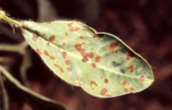DISEASE MANAGEMENT
Leaf spot or tikka disease
Causal organism: Cercospora arachidicola, Cercosporadium personatum
- Tikka is a major disease-affecting groundnut (and all its varieties) in India.
- It occurs as well in almost all groundnut-growing countries of the world.
Symptoms
- It occurs as two distinct types of leaf spot, namely, early leaf spot and late leaf spot.
- These are caused by two different species of fungi: Cercospora personatum and Cercospora arachidicola.
Early leaf spot
- The spots caused by C. arachidicola are sub irregular to circular, 1–10 mm in diameter.
- The lesions are dark brown and appear on the adaxial (upper) surface of the leaflets.
- Light brown lesions are found on the abaxial (lower) surface. The lesions are larger than those caused by C. personatum and are surrounded by a bright yellow, circular halo.
|
 |
 |
Late leaf spot
C. personatum causes small, dark spots which enlarge to about 3–8 mm diameter. Between few to several spots appear on each leaflet. These spots often coalesce to form irregular dark brown to black patches. The spots mostly appear on the leaf blades, but at times, they also appear on the petioles and the stem. The infected leaves drop off prematurely. The disease begins to appear a month after sowing and is severe during the flowering and harvesting stages.
Disease cycle
The infection initially originates with the fungus getting carried on plant debris or through the seed. During the initial stages the infection mostly occurs on the older leaves near the ground level. The conidia produced on these infections are disseminated by wind, rain and insects. This leads to secondary infection.
Management
- Sanitary precautions such as destroying the diseased plant debris would reduce the intensity of the disease.
- Intercrop groundnut and green gram (Vigna radiata) in the ratio of 4:1.
- Do seed treatment with asafoetida solution.
- Tolerant varieties like T-64, C-501, MH-4, TMV-6 and TMV-10 can be grown.
|
Rust
Causal organism: Puccinia arachidis
Rust occurs in south and central America, West Indies, Venezuela, China and India. It is one of the serious diseases of groundnut.
Symptoms
Orange-coloured pustules or uredinia appear on the lower surface of the leaves. They rupture to expose masses of urediniospores. The spores are reddish brown in colour. Corresponding to the sori, small, brown necrotic spots appear on the upper surface of the leaves. When the infection gets severe, the lower leaves wither and drop prematurely. The kernels formed in the infected plants are small and shriveled. The disease may occur on all aerial parts of the plant apart from the flowers and pegs. It occurs when the crop is over six weeks old.
Disease cycle
The pathogen is known by its uredinial stage. The dissemination of groundnut rust is by means of urediniospores.
Management
- Diseased plants should be removed and destroyed.
- Heavy growth of weeds may encourage disease development.
Hence, they should be kept under control.
- Monocropping of groundnut should be avoided.
|
Alternaria leaf spot
Causal organism: Alternaria helianthi
The disease commonly occurs in all varieties during the winter season and spreads rapidly during the rainy season.
Symptoms
The fungus causes brown spots on the leaves. They may also appear on the sepals, petals and stem. The lesions on the leaves are dark brown with a pale margin and a yellow halo. They are initially smaller in size and gradually enlarge up to 2–3 cm in diameter and form irregular circular lesions. |
Stem rot
Causal organism: Sclerotium rolfsii
Stem rot is a most important disease of groundnut in the USA. In India it occurs sporadically and causes yield loss of up to 27%. Symptoms The fungus attacks all parts of the plant but stem infection is the most common and serious. The branches that are in close or partial contact with the soil start wilting. The affected plant parts turn brown and small round bodies of about the size of a mustard seed are produced on the surface of the affected tissue. The leaves turn yellow and then brown and later desiccate. As the infection gets severe, a white thread-like fungal growth can be seen near the soil surface or just below the ground level. The entire plant may get killed or the branches of the plants alone may get affected. Infection of the pegs results in poor development of pods.
Disease cycle
The fungus is facultative and has a wide range of hosts. The sclerotia can survive in the soil for many years. The fungus multiplies readily on fallen leaves and branches. It is seed borne and present both internally and externally in the form of mycelium. Soil moisture plays an important role in fungal infection. At 40–50% soil moisture, the infection level can be high.
Management
- Infected plant debris should be collected and burned periodically.
- Crop rotation helps to keep the disease in check.
- Control of leaf spot disease prevents leaf dropping and indirectly controls stem rot by reducing the availability of nutrients to the pathogen.
|
Nutrient deficiency
Zinc
Zinc deficiency is most common in sandy and sandy-loam soils. Zinc deficiency usually results in reduction of flowers, poor development of pegs, root and shoot.
Boron
This deficiency has been reported in Punjab and Tamil Nadu. The threshold value for boron is 0.25 ppm. The deficiency causes hollow heart.
Iron
Lack of sufficient iron in the soil causes iron chlorosis, a condition that has been reported from Tamil Nadu, Gujarat, Karnataka and Maharashtra. It also occurs in calcareous black soils and sandy loams.
Source : Centre for Indian Knowledge Systems, Chennai
Updated on : Dec 2014 |
|

